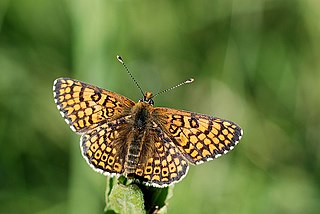
The Glanville fritillary is a butterfly of the family Nymphalidae. It is named for the naturalist who discovered it and the checkerboard pattern on its wings. These butterflies live in almost all of Europe, especially Finland, and in parts of northwest Africa. They are absent from the far north of Europe and parts of the Iberian Peninsula. To the east they are found across the Palearctic.

Melitaea diamina, the false heath fritillary, is a butterfly of the family Nymphalidae.

Melitaea is a genus of brush-footed butterflies. They are here placed in the tribe Melitaeini of subfamily Nymphalinae; some authors elevate this tribe to subfamily rank.

Melitaea aurelia, or Nickerl's fritillary, is a butterfly of the family Nymphalidae. It is found in central Europe.

Melitaea didyma, the spotted fritillary or red-band fritillary, is a Palearctic butterfly of the family Nymphalidae.

Melitaea phoebe, also known as the knapweed fritillary, is a butterfly of the family Nymphalidae. It is found in the Palearctic realm, except the northernmost locations. It used to include Melitaea telona, recently revalidated as a distinct cryptic species.

Melitaea trivia, the lesser spotted fritillary, is a butterfly of the family Nymphalidae, part of the sub-family Nymphalinae.

Antanartia, commonly called (African) admirals, is a genus in the family Nymphalidae found in southern Africa. They live along forest edges and are strongly attracted to rotting fruit and plant juices. For other admirals see genus, Vanessa. Recently, three species traditionally considered to be members of Antanartia have been moved to Vanessa based on molecular evidence. Antanartia borbonica was not sampled by the study, but was purported to belong in Antanartia based on morphological similarity.
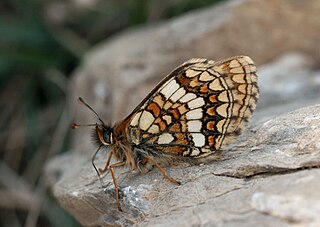
Melitaea varia, the Grisons fritillary, is a butterfly of the family Nymphalidae. It is found in the Alps at heights of 1,500–2,600 m (4,900–8,500 ft), especially in the Swiss cantons Valais, Engadin and Graubünden. It is also found in the Ortler region in South Tyrol, Alpes-Maritimes and Drôme in France, high areas of Tirol in Austria and high areas in the Apennine Mountains such as Abruzzo.
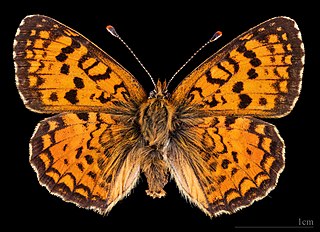
The aetherie fritillary is a butterfly in the family Nymphalidae.
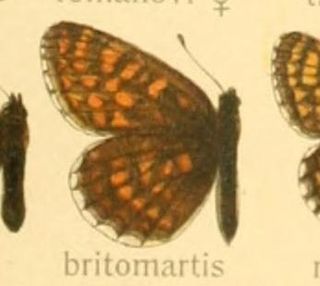
Melitaea britomartis, or Assmann's fritillary, is a butterfly in the family Nymphalidae. It has a wide geographic range and is represented by three subspecies.
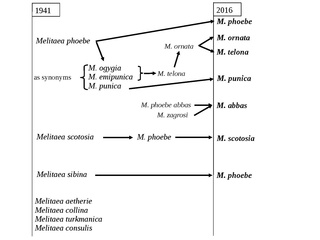
Melitaea ornata, the eastern knapweed fritillary, is a butterfly in the family Nymphalidae. The species rank of Melitaea ornata was only very recently recognised by two research groups independently. They realized that there was an unrecognised species in Europe under the name of M. phoebe. The separation of this cryptic species was based on larval morphology from the fourth instar onwards. M. phoebe larvae have a black head capsule while the larvae of this recently recognised Ponto-Mediterranean species have a brick-red head capsule. The separation of the two taxa was also supported by the results of enzyme electrophoresis study. Based on these observations, the name M. telona Fruhstorfer was taken into use for this species. In a recent molecular study, the M. phoebe group forms a monophyletic clade within the subgenus Didymaeformia. Although that study provided important results regarding the systematics of the genus, the members of the phoebe species group were poorly represented, and the need for a detailed examination of this group remained. One of the important results was the corroboration of the species rank of M. telona and the suggestion that the taxon punica may represent a separate species from both M. telona and M. phoebe. Another recent study on the morphometry of genitalia in males and females of the phoebe species group provided additional information. An analysis of a large number of specimens from the Palaearctic showed that Melitaea telona is not restricted to the Ponto-Mediterranean region since several new localities were found, including the Orenburg region (Russia), northern Iran and the easternmost border of Kazakhstan. Since the name ornata described by Hugo Theodor Christoph in 1893 is older than the name telona, the authors began to use M. ornata as the valid name for this species following the rule of priority. Recently, it has also been indicated that M. telonasensu stricto from Israel and M. ornata are different taxa. Previous morphometrical studies have already revealed small differences in the genital structures of the males but the authors interpreted the difference as a well-pronounced intra-specific difference. In contrast, molecular data clearly showed that the two taxa are genetically distinct from each other. Based on the results of the analysis of seven genes, Tóth et al. (2014) concluded that M. telona is not a subspecies of M. ornata but a species in its own right.

Melitaea protomedia is a butterfly of the family Nymphalidae. It is found in the Amur River basin in Russia and from central and eastern China to Korea and Japan. The habitat consists of flowering meadows, forest edges and clearings.

Melitaea arcesia, the blackvein fritillary, is a butterfly of the family Nymphalidae. It is found from southern Siberia and Transbaikalia to the Amur region, Mongolia and China. The habitat consists of steppe-clad slopes.
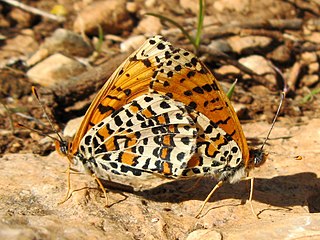
Melitaea deserticola, the desert fritillary, is a butterfly of the family Nymphalidae. It is found in North Africa, Lebanon, Israel, Jordan, Saudi Arabia and Yemen.

Melitaea persea is a butterfly of the family Nymphalidae. It is found from Iran and Asia Minor to Afghanistan and the western parts of the Tian Shan mountains.

Vanessa abyssinica, the Abyssinian admiral, is a butterfly in the family Nymphalidae. It is found in Ethiopia, Kenya, Tanzania, Uganda, Rwanda and the Democratic Republic of the Congo. The habitat consists of montane forests.

Issoria smaragdifera, the African queen fritillary, is a butterfly in the family Nymphalidae. It is found in Tanzania, Malawi, Zambia and Zimbabwe. The habitat consists of montane grassland on the edges of montane forests.

Melitaea nevadensis is a species of butterfly in the family Nymphalidae.
Melitaea acentria is a butterfly was discovered in 2017 by evolutionary biologist-entomologist Vladimir Lukhtanov over Mount Hermon ski resort, northern Israel. When it was first seen in 2012 it was incorrectly believed that it belonged to the Persian fritillary (Melitaea persea) species due to its similar appearance. Once the internal anatomy and DNA was researched, this was discounted as it had the Acentria's fritillary DNA, different genitalia and a unique molecular signature. It is more than 1.5 million years old and is Israel’s first newly-discovered butterfly species in over a century. Its natural habitat is northern Israel, Syria and Lebanon. It is among a very few butterflies that has resulted from hybridisation between two other species in the past.

















